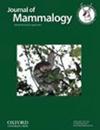In the Lyme light: individual trait determinants of Borrelia burgdorferi infection in Peromyscus mice
IF 1.5
3区 生物学
Q2 ZOOLOGY
引用次数: 0
Abstract
Disease ecologists commonly use abiotic factors (e.g. temperature and moisture) or measures of biodiversity (e.g. species richness) to predict Lyme disease transmission patterns, but variance in infection probability among individuals within a population is poorly understood. Most studies assume intraspecific consistency, but recent evidence suggests that individual traits, such as animal personality, may drive differences in encounter rates with infected vectors and pathogen transmission probabilities through differential space use and microhabitat selection, leading to intraspecific variation in infection probability. In addition, because vectors and hosts are nonrandomly distributed across a landscape, land-use changes that modify key habitat features—such as forest management practices—may substantially alter associations between individual traits and infection probability. To address these gaps in our knowledge, we used a large-scale capture–mark–recapture study targeting Peromyscus mice in Maine, United States, to test whether personality drives probability of Borrelia burgdorferi infection in hosts within managed forest compartments with different silvicultural treatments. Specifically, we tested effects of individual phenotypic traits (physical and behavioral) and environmental traits (microhabitat and forest type) on infection probability within 2 species: P. leucopus and P. maniculatus. We found evidence that boldness negatively influences infection probability in P. maniculatus, and that body mass positively influences infection probability in both species. We found no effect of mouse density, microhabitat, or forest type in our analyses. These results suggest that personalities vary in their functional contributions to the natural cycle of B. burgdorferi, and that broader integration of behavioral diversity in disease ecology studies may aid in identifying key transmission zones for this rapidly expanding vector-borne zoonosis.在莱姆光:个体性状决定因素伯氏疏螺旋体感染的Peromyscus小鼠
疾病生态学家通常使用非生物因素(如温度和湿度)或生物多样性措施(如物种丰富度)来预测莱姆病的传播模式,但人们对种群中个体之间感染概率的差异知之甚少。大多数研究假设种内一致性,但最近的证据表明,个体特征,如动物个性,可能通过不同的空间利用和微生境选择导致与感染媒介的相遇率和病原体传播概率的差异,从而导致感染概率的种内变化。此外,由于病媒和宿主在景观中非随机分布,改变关键栖息地特征的土地利用变化(如森林管理实践)可能会大大改变个体特征与感染概率之间的关系。为了解决我们知识上的这些空白,我们使用了一项针对美国缅因州Peromyscus小鼠的大规模捕获-标记-再捕获研究,以测试在不同造林处理的管理森林隔间中,性格是否驱动宿主感染伯氏疏疏体的概率。具体地说,我们测试了个体表型性状(生理和行为)和环境性状(微生境和森林类型)对2种P. leucopus和P. maniculatus感染概率的影响。我们发现有证据表明,大胆度对马齿虎的感染概率有负向影响,而体重对两种物种的感染概率都有正向影响。在我们的分析中,我们没有发现老鼠密度、微生境或森林类型的影响。这些结果表明,个性对伯氏疏螺旋体自然循环的功能贡献各不相同,并且在疾病生态学研究中更广泛地整合行为多样性可能有助于确定这种迅速扩大的媒介传播的人畜共患病的关键传播区。
本文章由计算机程序翻译,如有差异,请以英文原文为准。
求助全文
约1分钟内获得全文
求助全文
来源期刊

Journal of Mammalogy
生物-动物学
CiteScore
3.30
自引率
5.90%
发文量
106
审稿时长
4-8 weeks
期刊介绍:
Papers are published on mammalian behavior, conservation, ecology, genetics, morphology, physiology, and taxonomy.
 求助内容:
求助内容: 应助结果提醒方式:
应助结果提醒方式:


